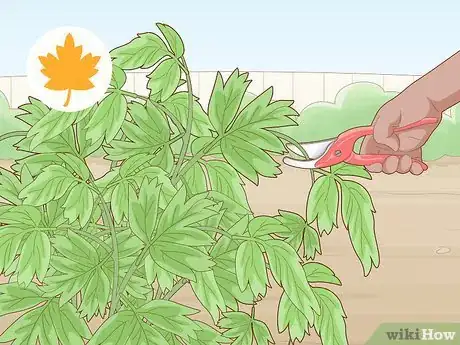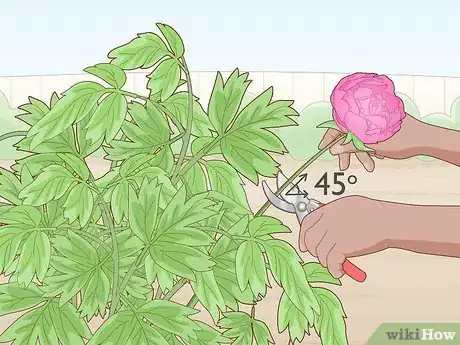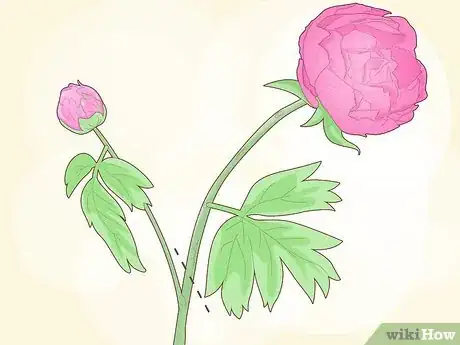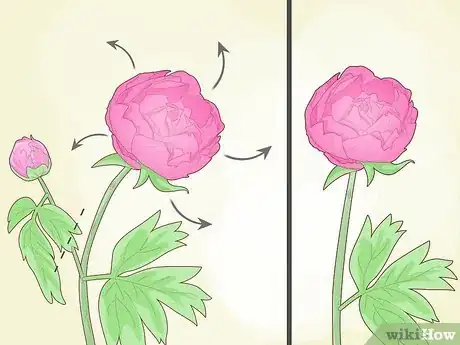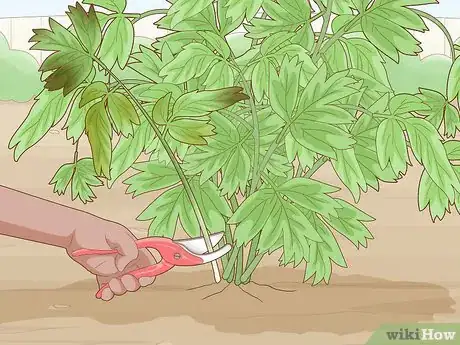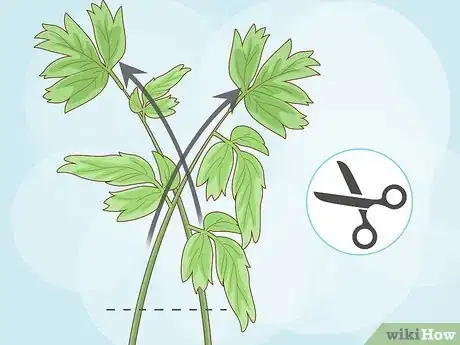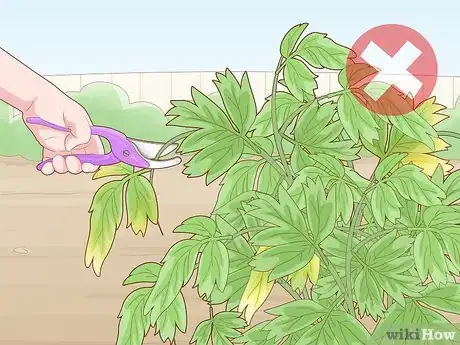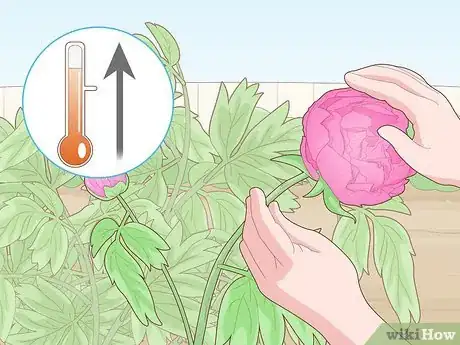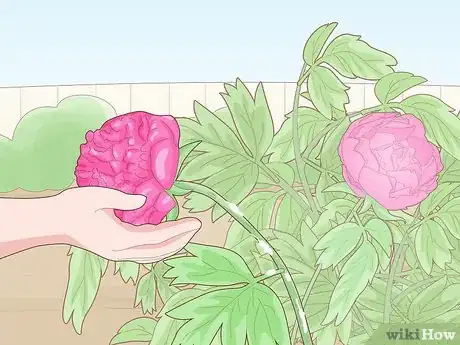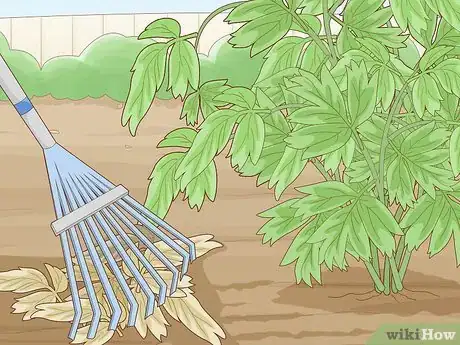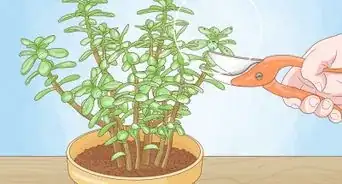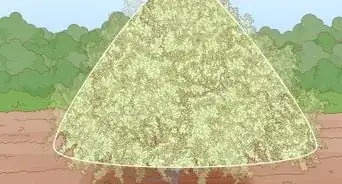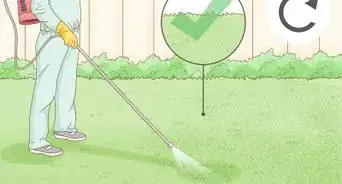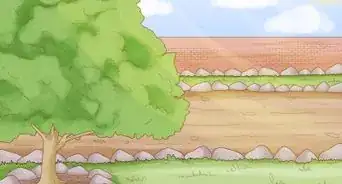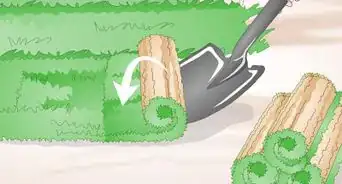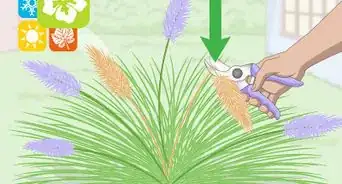This article was co-authored by Grant Wallace and by wikiHow staff writer, Hannah Madden. Grant Wallace is a Landscaper and Owner of Grantlanta Lawn in Atlanta, Georgia. With over seven years of experience, he specializes in lawn maintenance and landscape installation. In 2012, he earned his BA from the University of West Georgia. Grant has been profiled in Shoutout Atlanta, Canvas Rebel, and Voyage ATL.
This article has been viewed 19,839 times.
Peonies are perennial bushes that lose most of their leaves during the winter and then bounce back for a beautiful bloom in the spring. These bushes produce large, brightly-colored flowers in red, white, yellow, or pink to brighten up your lawn and make your garden feel like springtime. You can keep your peony bush healthy by pruning it once in the fall and doing minor maintenance pruning during the growing season.
Steps
Winterizing Peonies in the Fall
-
1Prune peonies in the fall to get them ready for spring. Most peony varieties bloom in the spring and die back in the winter. Wait until the leaves of the plant start to turn brown or yellow to start pruning. In most climates, this happens around late September or early October.[1]
- The cuts you make in the fall will affect where new growth appears in the spring.
- If you live in a super cold climate, your plant may start to brown as early as mid-September.
-
2Hold your pruners at a 45-degree angle as you make cuts. Pick up a pair of sharp pruning shears and hold them at a 45-degree angle. Keep them at this angle whenever you make your cuts so that the branches of the peony bush end in an angled point.[2]
- Cutting at an angle will prevent water from pooling on the cut ends of the stem, which could lead to disease or rot.
Advertisement -
3Make cuts just above the buds on every stem. The buds, or the small bumps on each stem, are what produce flowers. As you make your cuts, try to leave the buds intact so that they can bloom into flowers in the spring.[3]
- Leaving the buds intact will help your peony bush produce more flowers in the spring.
-
4Cut off the buds on the sides at a 45-degree angle to bloom 1 large flower. If you want your peony bush to focus on making large flowers at the end of each branch, use your pruners to remove the smaller buds on the sides of the branches. Remember to hold your pruners at a 45-degree angle as you cut.[4]
- If you want more small flowers, cut off the large bud at the end of the branch and leave the smaller buds intact.
-
5Remove any branches that are covered in insects. Although it is not common, peonies sometimes get pests like eelworms or caterpillars in and on top of their branches. If you see any branches that are covered in small insects, use your pruners to clip them back.[5]
- If your peony bush has ants on it, you don’t need to worry. Ants are harmless to a peony bush.
-
6Cut back the entire diseased branch to get rid of it. Take your pruners and hold them just below the diseased part of the branch. Cut it off at an angle so you remove the diseased part of the stem. If the base of the branch is not discolored, don’t cut it off.[6]
- Clean your pruners with rubbing alcohol after each cut you make on a diseased branch. This will prevent the spread of the disease as you cut the rest of the peony bush.
- Throw diseased and insect infested branches into the garbage, not your compost pile. That way, they won’t be able to infect any other foliage you have.
-
7Trim back any branches that are rubbing against each other. Take a look around your peony bush and notice if there are any branches that cross or intersect. If there are, cut back the smaller branch to free them up and stop them from rubbing together.[7]
- Branches rubbing together can rub a hole in the stems of your peony, which can leave it vulnerable to insects and disease.
-
8Leave any foliage intact so you don’t hurt your peony. Even if the leaves of your peony bush are starting to turn yellow or brown, it’s important to leave them be so they can conserve energy for the spring. Don’t cut off any leaves and try to avoid ripping or tearing them accidentally as you prune.[8]
Variation: Herbaceous peonies will lose their foliage on their own during the fall. If your peony is herbaceous, don’t be alarmed if all of the leaves fall off in late September or early October.
Maintaining Blooms in the Spring and Summer
-
1Monitor your peonies as they bloom in the spring and summer. As the temperatures start to rise in your area, keep an eye on the branches of your peonies to see if they become discolored or warped. You can also look at how many flowers they are producing and cut them back if you need to.[9]
- In most areas, peonies start blooming around late March or early April.
-
2Look for discolored or misshapen branches to spot disease. Branches that are yellow or brown are probably dead or dying, so they won’t produce flowers anymore. Look in the center of your peony bush to spot branches like these so they don’t infect the entire bush.[10]
- If you do find diseased branches, use your pruners to cut them off at the base of the branch.
Did You Know? Peonies can sometimes develop mold, which looks black or brown, or fungus, which looks white.[11]
-
3Remove the faded flowers if you’d like to. Getting rid of the dead flowers, or deadheading, won’t actually divert energy into new growth on a peony. However, if there are a lot of dead flowers on your bush and you’d like to get rid of them, make a small cut with your pruners just below the base of the flower to get rid of them.[12]
- Getting rid of discolored flowers can protect your plant from rotting as the flowers die and fall off.
-
4Rake up the leaves around the base of the peony. After you’re done pruning, take a rake and use it to clean up the area beneath the peony bush. Make sure to discard of any foliage that fell off so it doesn’t rot as the ground gets wet.[13]
- As long as the foliage isn’t diseased or insect infested, you can put it in your compost pile or yard debris bin.
Things You’ll Need
Winterizing Peonies in the Fall
- Pruners
Maintaining Blooms in the Spring and Summer
- Pruners
- Rubbing alcohol
- Rake
References
- ↑ http://www.missouribotanicalgarden.org/PlantFinder/PlantFinderDetails.aspx?kempercode=q400
- ↑ http://www.missouribotanicalgarden.org/PlantFinder/PlantFinderDetails.aspx?kempercode=q400
- ↑ https://gardentabs.com/cut-back-peonies/
- ↑ https://www.rhs.org.uk/Plants/182524/Paeonia-lactiflora-Gardenia/Details
- ↑ http://www.missouribotanicalgarden.org/PlantFinder/PlantFinderDetails.aspx?kempercode=q400
- ↑ https://ucanr.edu/sites/gardenweb/files/28952.pdf
- ↑ https://www.rhs.org.uk/Plants/182524/Paeonia-lactiflora-Gardenia/Details
- ↑ https://www.rhs.org.uk/Plants/182524/Paeonia-lactiflora-Gardenia/Details
- ↑ https://gardentabs.com/cut-back-peonies/
- ↑ https://www.rhs.org.uk/Plants/182524/Paeonia-lactiflora-Gardenia/Details
- ↑ https://apps.extension.umn.edu/garden/diagnose/plant/annualperennial/peony/flowersbrown.html
- ↑ http://www.missouribotanicalgarden.org/PlantFinder/PlantFinderDetails.aspx?kempercode=q400
- ↑ https://www.rhs.org.uk/Plants/182524/Paeonia-lactiflora-Gardenia/Details
